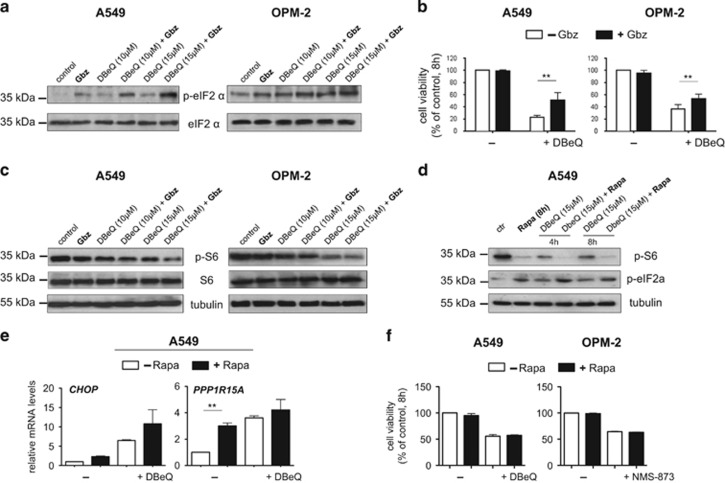Figure 3.
Impact of PPP1R15A/PP1c and mTORC1 signaling on proteotoxicity triggered by VCP inhibition. (a) Guanabenz treatment is associated with increased levels of eIF2α phosphorylation. Representative immunoblots with antibodies against phosphorylated (Serine 51) and total eIF2α on whole-cell extracts from A549 and OPM-2 cells treated for 8 h with DBeQ as indicated in the absence or presence of guanabenz (Gbz, 2.5 μM). (b) Guanabenz reduces VCP inhibitor-mediated cell death. Cell viability after treatment with DBeQ (15 μM) in the absence or presence of guanabenz (Gbz, 2.5 μM) for 8 h. (c) Guanabenz decreases S6 phosphorylation as a readout for mTORC1 activity. Representative immunoblots with antibodies against phosphorylated (Serine 235/236) and total ribosomal protein S6 on whole-cell extracts from A549 cells after treatement with or without rapamycin (Rapa) as indicated. (d) mTORC1 inhibition has an impact on eIF2α phosphorylation. Immunoblottings demonstrating the effects of the mTORC1 inhibitor rapamycin (Rapa, 20 nM) on S6 and eIF2α phosphorylation in unstressed cells and cells treated with DBeQ. (e) The impact of mTORC1 inhibition on the indicated mRNA levels after VCP inhibition for 8 h. (f) Rapamycin does not modulate VCP inhibitor-induced cell death. Cell viability was determined after treatment with rapamycin (Rapa, 20 nM), DbeQ (15 μM), and NMS-873 (10 μM) for 8 h. Data shown in (b), (e), and (f) are the mean±S.E.M. from three independent experiments; **P<0.01

